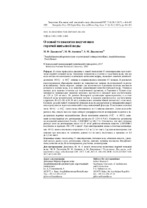О новой технологии подготовки горячей питьевой воды

Date
2017Publisher
Another Title
On a New Technology of Preparation of Hot Drinking Water
Bibliographic entry
Джалилов, М. Ф. О новой технологии подготовки горячей питьевой воды = On a New Technology of Preparation of Hot Drinking Water / М. Ф. Джалилов, М. М. Азимова, А. М. Джалилова // Энергетика. Известия высших учебных заведений и энергетических объединений СНГ. – 2017. – № 5. – С. 484-492.
Abstract
В статье приводятся сведения о новой технологии Cl-анионирования при подготовке горячей питьевой воды. Указанная технология в отличие от умягчения воды, где все соли жесткости замещаются в катионите катионами натрия, позволяет заменить накипеобразующие HCO⁻₃ - и SO²⁻₄ -анионы в сильноосновном анионите Cl⁻-ионами. В результате предотвращается образование накипи на поверхностях нагрева подогревателей горячего водоснабжения. Таким образом, ценные для человеческого организма катионы жесткости остаются в составе воды, и ее качество удовлетворяет качеству питьевой воды. Учитывая важную роль кальция и магния для человеческого организма, в Германии и Турции ограничивается минимальное значение катионов жесткости в питьевой воде соответственно до 2,85 и 7,50 мг-экв/л. По данным Всемирной организации здравоохранения, в составе питьевой воды концентрация катионов магния и кальция рекомендуется соответственно в пределах 10–(20–30) и 20–50 мг/л; минимальное значение общей жесткости 2–4 мг-экв/л. Согласно разработанной технологии питьевая вода последовательно в направлении сверху вниз пропускается через механический и хлор-анионитный фильтры. В последнем основная часть HCO⁻₃ - и SO²⁻₄ -ионов воды обменивается на Cl-анионы анионита. Далее вода собирается в бак, откуда насосом через аппарат ультрафиолетовой дезинфекции подается в подогреватель горячего водоснабжения. После истощения анионита SO²⁻₄ и HCO⁻₃ -анионами осуществляется его регенерация раствором (8–12)%-й NaCl. Излагаются результаты исследований анионитами Purolite A200EMBCl и АВ-17-8. Отмечается, что при удельном расходе соли на регенерацию около 45–55 кг/м³ рабочая обменная емкость A200EMBCl получается в пределах 300–370 г-экв/м³. При анионировании воды остаточная концентрация HCO⁻₃ -ионов изменялась в пределах от 0,5 до 3,2 мг-экв/л. Средняя концентрация этих анионов при исходном их значении, равном 4,4 мг-экв/л, получилась в пределах от 1,8 до 2,2 мг-экв/л.
Abstract in another language
The present article contains information concerning the new Cl-anionization technology in the preparation of hot drinking water. In contrast with water softening, that replaces all the hardness salts by sodium cations in the cation exchanger, this new technology makes it possible to replace incrustating HCO⁻₃ - and SO²⁻₄ -anions in a strong-base anion exchanger by Cl⁻-ions. As a result, the incrustation on the surfaces of heating hot water heaters is prevented. Thus, cations of hardness that are valuable for the human body remain in the water, the quality of the latter conforming to drinking water quality. Considering the important role of calcium and magnesium in the human body, in Germany and Turkey the minimum value of hardness cations in drinking water is limited to 2.85 and 7.50 mg-Eqv/l, respectively. According to the World Health Organization, in the composition of drinking water, the concentration of cations of magnesium and calcium is recommended, respectively, within 10–(20–30), and 20–50 mg/l; the minimum value of total hardness is 2–4 mg-Eqv/l. According to the developed technology drinking water is passed consistently in the downward direction through the mechanical and chlorineanionite exchanger filters. In the latter, the main part of HCO⁻₃ - and SO²⁻₄ -water ions are exchanged for Cl-anions of anionite. Then the water is collected in the tank, from where it is pumped to the hot water heater through the ultraviolet disinfection unit. After the depletion of the anionite by SO²⁻₄ - and HCO⁻₃ -anions, it is regenerated by a solution of 8–12 % NaCl. The results of research by the anion exchangers Purolite A200EMBCl and AB-17-8 are plotted. It is noted that when the specific consumption of salt for regeneration is of about 45–55 kg/m³, working exchange capacity of the A200EMBCl occurs to be in the range 300–370 g-Eqv/m³. For anionization of water, the residual concentration of HCO⁻₃ -ions are changed from 0.5 to 3.2 mg-Eqv/l. The average concentration of these anions occurs to be between 1.8 and 2.2 mg-Eqv/l, when their initial value is 4.4 mg-Eqv/l.
View/
Collections
- №5[8]
